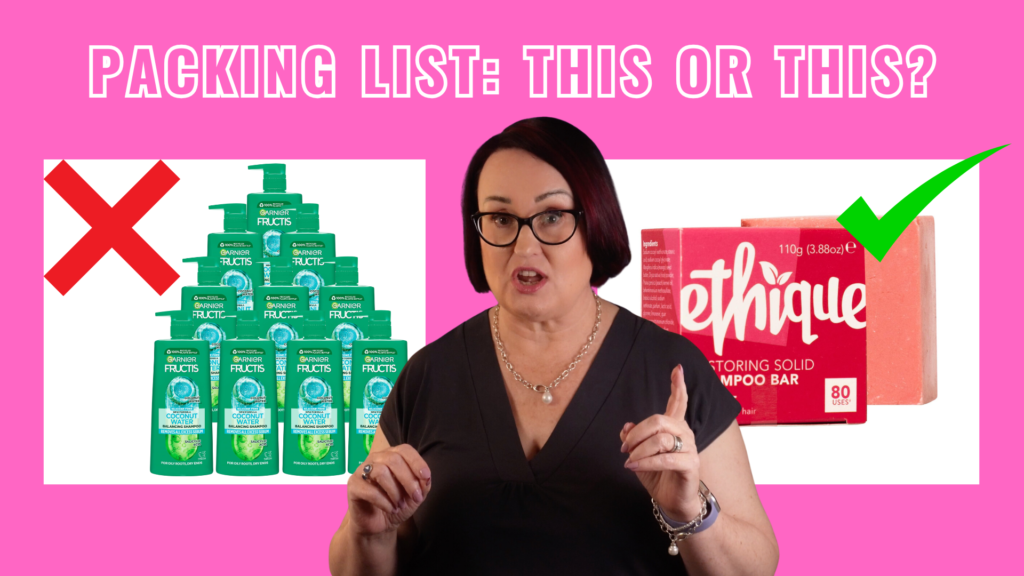LIGHTEN your travel toiletries kit

Are you attempting one bag travel or just wish you could reduce the size of your travel toiletries kit? My travel hacks will help you travel light and minimize your travel size toiletries. No more worrying about the 3-1-1 rule! Now, let me be honest—I’m not someone who travels with just a carry-on bag. I usually check a suitcase. However, over the last couple of years, I’ve been working hard to lighten our luggage, particularly when it comes to toiletries. You might be wondering why I’m so focused on packing light today. Well, we’re gearing up for a six-week adventure in North America and Bermuda! We’re incredibly excited—we’ll be cruising from Montreal to New York, spending two fantastic weeks in New York City, and then enjoying a seven-day round trip cruise to Bermuda before heading back home to Australia. But there’s been a little twist that has influenced our packing strategy—Michael recently had a fall at home! He tripped over a step (nothing spectacular) and ended up dislocating his shoulder and fracturing the humerus in two places. Ouch! He’s recovering after surgery, but since he’ll be in a sling until we depart, we need to keep our luggage light to make things easier for both of us. The bulk of our packing reduction starts with liquids. Most liquids pack a heavy punch due to their high water content. So, I want to pass on the benefits of my research to you! We’ll cover the rules for taking liquids onboard the plane, explore alternatives to liquids, discuss what to leave behind, and finally, how to pack everything effectively. Onboard liquids I’m Australian, but the TSA rules in the USA often come to mind when I think about onboard liquid regulations. Most countries have similar restrictions but remember to check the specific regulations for the country you’re visiting. For instance, the UK has different requirements for the size of clear bags! Leaving Australia on an international flight, the rules relate to powders, liquids, aerosols and gels. I won’t go into details but certain powders, such as washing powder and salt need to be under 350g but don’t have to be packed in a special bag. Liquids, aerosols and gels must be under 100ml and packed in a zip lock bag that measures 80cm or less around the perimeter. All powder, liquid, aerosol and gel products must be taken out at security. You can have one liquids bag per person. Personally, I’ve had good luck getting through without having to pull them out, but it’s always best to follow the packing guidelines just in case. Flying in the USA you have the 3 1 1 rule – each product must be under 3.4 ounces, which is 100ml, be put in a bag that is 1 quart or less (just under a litre) and one bag is allowed per person. I’ve included links in the text above, but I found this information quite easily by searching “flying liquids Australia” and “flying liquids USA” so do the same for the country you’re visiting to ensure that you know what to do. Now, we get to the tricky part—what actually counts as a liquid? Items like mascara and lipstick often cause confusion. A handy tip is to think about whether the product can hold its shape without a container at room temperature. Mascara would definitely be considered a liquid, whereas a lipstick would not—although lip gloss? Yep, that’s a liquid! Don’t forget, there are exemptions for things like medications and baby food, but it’s wise to check the regulations specific to the country you’re visiting. Of course, none of this applies to liquids in checked in bags, but if you are going to travel carry on only you will need to have a really good understanding of the rules! Replacements Why bother with liquids when you can replace them with solid alternatives? Liquid products tend to be heavier, simply because they usually have a higher water content. For example, when I weighed a litre of milk, it clocked in at about one kilo (35.27oz). Meanwhile, the milk powder to make one litre weighed only 130 grams (4.59oz). You can see it by looking at the ingredients list on any product – the ingredients are listed from highest to lowest percentage and the first one is nearly always aqua – that’s water! Take shampoo, for instance. I carry a mini shampoo bar instead of liquid shampoo when I travel. I’ve been using a sample sized bar for six weeks of travel all up, and it’s barely any smaller. I can still see the embossed pattern on it, which tells you just how little has been worn away. If I’d taken liquid shampoo I would have used a fairly large bottle over the same period, and the whole bar must be worth at least ten bottles! There are two more reasons I prefer non-liquid alternatives, and they don’t relate to travel – one is environmental – producing and transporting a shampoo bar instead of ten bottles has a much lower impact on the environment. The second is frugality – it costs a whole lot less for that one bar instead of ten bottles of shampoo! So, at home I use a shampoo bar and toothpaste tablets and plan to replace other items as I run out of the liquid versions. Now, you might have stumbled upon YouTube videos where some travellers have gone completely non-liquid with their toiletries. While I admire that approach, I’ve learned that there are some items I prefer in liquid form—like body lotion, for example. However, even if you switch out just half or a quarter of your products, you’re already making a substantial difference! For my hair care, I use a full-sized Ethique shampoo bar at home. For travel, I have a travel-sized Superzero shampoo bar—thank you, Sephora, for that gift with purchase! I’ve been using the Ethique bar for about 18 months, and I’d estimate it’s just over half used. I

